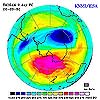| . |  |
. |
This year's Antarctic ozone hole is the second largest ever observed, according to scientists from NASA, the National Oceanic and Atmospheric Administration (NOAA), and the Naval Research Laboratory. The Antarctic ozone hole is defined as thinning of the ozone layer over the continent to levels significantly below pre-1979 levels. Ozone blocks harmful ultraviolet "B" rays. Loss of stratospheric ozone has been linked to skin cancer in humans and other adverse biological effects on plants and animals. The size of this year's hole reached 10.9 million square miles on September 11, 2003. It was slightly larger than the North American continent, but smaller than the largest hole ever recorded, on September 10, 2000, when it covered 11.5 million square miles. Last year the ozone hole was smaller, covering 8.1 million square miles. NASA's Earth Probe Total Ozone Mapping Spectrometer and the NOAA-16 Solar Backscatter Ultraviolet instrument provided ozone measurements from space. These data were coupled with data collected by NOAA's Climate Monitoring and Diagnostics Laboratory (CMDL) from balloon-borne instruments, which measure the ozone hole's vertical structure. NASA's own scientist Paul Newman said, "While chlorine and bromine chemicals cause the ozone hole, extremely cold temperatures, especially near the edge of Antarctica, are also key factors in ozone loss." Given the leveling or slowly declining atmospheric abundance of ozone-destroying gases, the year-to-year changes in the size and depth of the ozone hole are dominated by the year-to-year variations in temperature in this part of the atmosphere. The fact this year's ozone loss is much greater than last year's reflects the very different meteorological conditions between these two years. NASA scientist Rich McPeters said ozone observations showed the total amount of ozone from surface to space was 106 Dobson Units (DU) on September 14, 2003, the minimum value reached this year. "Dobson units" measure the "thickness" of protective ozone in the stratosphere. They range from 100 DU to 500 DU, which translate to about 1 millimeter (1/25 inch) to 5 millimeters (1/5 inch) of ozone in a layer. Bryan Johnson of CMDL said the ozone depletion region, from 7-to-14 miles above the Earth, has large losses, similar to losses seen in the 1990s. If the stratospheric temperature remains cold over the pole, then we should see complete ozone loss in the 9-13 mile layer, with total column ozone reaching 100 DU by early October. The Montreal Protocol and its amendments banned chlorine-containing chlorofluorocarbons (CFCs) and bromine-containing halons in 1995, because of their destructive effect on the ozone. However, CFCs and halons are extremely long-lived and still linger at high concentrations in the atmosphere. However, the atmospheric abundances of ozone destroying chemicals are beginning to decline. As a result, the Antarctic ozone hole should disappear in about 50 years. NASA's Earth Science Enterprise is dedicated to understanding the Earth as an integrated system and applying Earth System Science to improve prediction of climate, weather, and natural hazards using the unique vantage point of space. Related Links NASA's Goddard Space Flight Center SpaceDaily Search SpaceDaily Subscribe To SpaceDaily Express  Washington - Sep 01, 2003
Washington - Sep 01, 2003Researchers have discovered that total bromine in the lower atmosphere has been decreasing since 1998 and is now more than five percent below the peak reached that year. Bromine is one of the most active destroyers of the stratospheric ozone layer, which forms an invisible shield around the Earth, protecting it from the biologically damaging ultraviolet rays of the Sun.
|
| ||||||||||
| The content herein, unless otherwise known to be public domain, are Copyright 1995-2016 - Space Media Network. All websites are published in Australia and are solely subject to Australian law and governed by Fair Use principals for news reporting and research purposes. AFP, UPI and IANS news wire stories are copyright Agence France-Presse, United Press International and Indo-Asia News Service. ESA news reports are copyright European Space Agency. All NASA sourced material is public domain. Additional copyrights may apply in whole or part to other bona fide parties. Advertising does not imply endorsement, agreement or approval of any opinions, statements or information provided by Space Media Network on any Web page published or hosted by Space Media Network. Privacy Statement All images and articles appearing on Space Media Network have been edited or digitally altered in some way. Any requests to remove copyright material will be acted upon in a timely and appropriate manner. Any attempt to extort money from Space Media Network will be ignored and reported to Australian Law Enforcement Agencies as a potential case of financial fraud involving the use of a telephonic carriage device or postal service. |